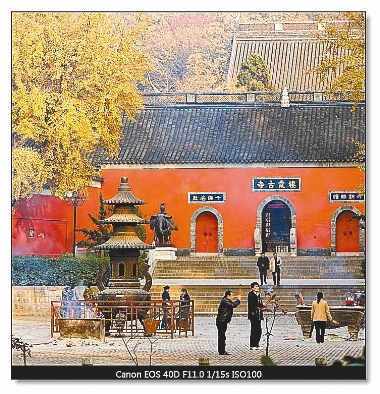 ONE falling leaf is a sign that autumn is on its way, says a Chinese proverb. But before the trees become bare, seize the chance to see some colorful landscapes in mountain and forest parks. Tianping Mt. in Suzhou Situated 30 kilometers to the west of Suzhou City in Jiangsu Province, Tianping Mountain is famous for its grotesque rock formations, crystal-clear streams and red maple leaves. At the southern foot of Tianping Mountain, over 170 maples, some of which stand over 30 meters high, were planted during the Ming Dynasty (1368-1644) and with those planted in recent years. The maples produce a spectacular natural scene in late autumn, and attract a lot of tourists at this time of year. There is a Red Maple Art Festival, showcasing performances in local style, including Chinese opera, art and craft. Contests related to red maples are also being organized for visitors to write poems and essays, take photographs, or try calligraphy. Transport: Fly to Hangzhou from Shenzhen Bao’an International Airport, then take a bus to Suzhou and Tianping Mountain. Cuisine: Try crabs, noodles, bean curd, fish, pork and snacks. Qixia Mountain in Nanjing Famous for its maple trees, Qixia Mountain attracts thousands of campers every autumn who are attracted to the crimson maple leaves that cover most of the mountain. It is located in the northeast part of Nanjing, the capital of Jiangsu Province. During the Southern Dynasties (420-589), a Buddhist temple, called Qixia, was built there, hence the mountain’s name. This scenic spot has a peak of 286 meters. Emperor Qianlong of the Qing Dynasty (1644-1911) called it “the brightest and most elegant mountain in Nanjing.” Qixia Mountain also has many fossils that attract geology enthusiasts. Other trees on the mountain include sweet gums, red maple, Japanese maple and Acer palmatum. Transport: Fly to Nanjing from Shenzhen Bao’an International Airport, then take a bus to Qixia Mountain. Cuisine: Chicken, ducks, fish, pork and bean curd are recommended. Yuelu Montain is located to the west of Xiangjiang River in Changsha, Hunan Province. Its highest point, Yunlu Peak, is about 300 meters above sea level. At this time of year, the mountain’s maple leaves are at their most attractive. The mountain is noted for its many scenic spots, including Qingfeng Gorge, Aiwan Pavilion, Lushan Temple, Yunlu Palace, White Crane Spring and Flying Stone. Qingfeng Gorge lies in the low area between Yuelu Academy and Lushan Temple. It holds Aiwan Pavilion, one of four famous pavilions in ancient China, the Sheli Tower, and the tombs of Huang Xing (1874-1916) and Cai E (1882-1916), who both contributed much to China. Yunlu Palace is part of Yuelu Mountain’s long history of Taoist activities. The palace was built in 1478, and the mountain has been an active center for such activities ever since. Transport: Fly to Changsha from Shenzhen Bao’an International Airport, then take a bus to Yuelu Mountain. Cuisine: Pork, vegetables, frogs, soup, ducks and shrimps are recommended. (Jane Lai) | 
